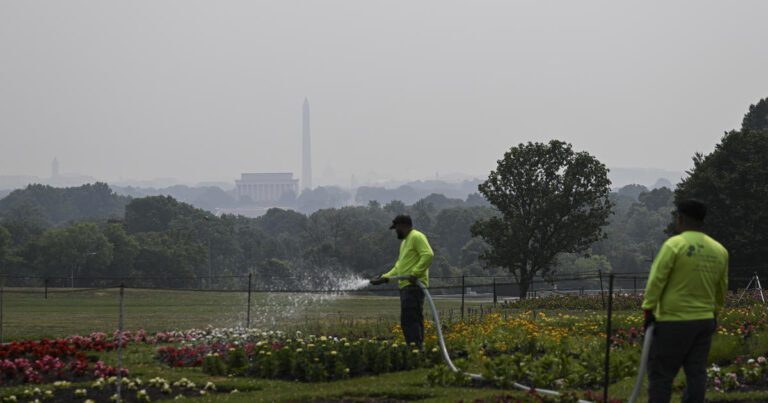With the smoke from burning Canadian forests enveloping the northeastern US, major cities fell silent this week. Public Schools outdoor activities were cancelledcompanies sent workers homeperformances were postponed, libraries closed their doors and professionals baseball games were canceled.
Such disruptions to ordinary urban life demonstrate the widespread economic burden of climate change, which experts say is making wildfires more intense and contributing to air pollution.
“It's gray and the sun looked orange in the sky this morning, like Star Wars or something,” Paul Billings, national vice president of public policy at the American Lung Association, told CBS MoneyWatch from Washington, DC.
“It's really early in the season, we're still in the spring, and we're seeing these wildfires in Canada and the U.S. that are affecting air quality in the eastern United States. In New England, the mid-Atlantic and within Minnesota, we're seeing increased levels of particulate matter or soot “, he added.
These tiny particles are especially dangerous for people with heart disease, asthma, or chronic obstructive pulmonary disease (COPD), but they pose risks to everyone, including risks of asthma attacks, heart attack, stroke, or early death.
“Some people have to take their medications longer — others end up in the emergency room,” Billings said.
Because the type of particles found in smoke are so small, they get past the body's natural defenses, such as the mucous membranes in the nose and throat, as well as the body's coughing mechanism.
“They get deep into the lungs and where you have oxygen exchange systems,” Billings said. “These particles actually get into your blood and create a wide range of bad health outcomes, including strokes, heart attacks and various types of cancer.”
Forest fires aren't the only source of particulate matter—diesel trucks and coal-fired electricity have historically contributed the lion's share of air pollution. But wildfires are a growing factor. The increased frequency of wildfires in a hotter, drier climate has reversed some of the air quality improvements since the 1970 Clean Air Act, the American Lung Association noted in an April report.
“Amazing” cost
Earth's warming climate is contributing to the problem, with temperatures in Canada unusually hot this year. Lytton, British Columbia — usually a temperate town — hit a record high of 121 last week, tying California's Death Valley. Hot, dry weather makes a forest more likely to catch fire and burn more. Already, of Canada fire season is on track to be the most destructive in the country's history.
Globally, air pollution kills more than 3 million people annually, according to the World Health Organization. In dollar terms, the cost is enormous and is reflected in increased hospitalizations, lost days of work and school, and lower worker productivity.
“The cost is staggering,” Billings said
Air pollution adds $2,500 a year to the average American's medical bills, according to a recent study by the Natural Resources Defense Council. Across the U.S., smoke, factory production and automobile exhaust costs the economy $800 billion a year, or about 3 percent of the nation's total economic output, according to the NRDC.
Perhaps unsurprisingly, high levels of air pollution also reduce earnings by making work more difficult and unpleasant, adding a significant impact on the economy. Outdoor workers, such as delivery workers, and landscapers and teachers are more affected, but office workers aren't necessarily safe. Even indoor air pollution spikes to three or four times safe levels during a fire event, studies show were found.
$125 billion in lost pay
Stanford researchers who mapped wildfire plumes in the US found that one day of smoke exposure reduces a person's quarterly earnings by 0.1%, according to a recent employee document published by National Bureau of Economic Research. Across the U.S. as a whole, workers lost $125 billion a year to wildfire smoke, according to the paper — about 2 percent of total labor income.
In addition to smoke, warmer air also increases production ozo, a major component of smog and a lung irritant. “Some researchers have likened it to a sunburn on the lungs — your cells get irritated and cry,” Billings said.
Celal Gunes/Anadolu Agency via Getty Images
As with other types of pollution, the effects of ozone, smog and smoke are not evenly distributed, with low-income people and people of color more likely to be exposed, according to the ALA.
Businesses and governments can take a number of steps, such as improving indoor filtration, not forcing workers to go outside, and notifying public service alerts about air quality. But long-term reductions in the end of air pollution mean widespread electrification, Billings said. This would reduce emissions from transport and factories.
“I think too often, people see them as anomalous weather,” he said. “This is not a fire incident. It's early June. There have always been fires, but the big driver that creates these warm, dry conditions that create the opportunities for these fires is climate change.”



